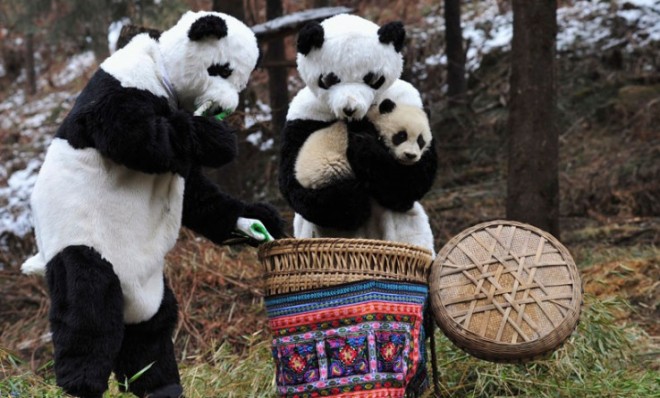The extremely endearing, scary, and gross lengths zookeepers go to for their animals
Dressing up in urine-soaked panda costumes is not even the worst of it


Ever wonder what it's like to be a zookeeper? Do you ever think, as I do, how lucky they are to spend their days ogling adorable animals? Well, my friends, you don't know the half of it. Sure, the proximity to cute newborns is a perk, but when giant poop patrol isn't keeping these dedicated workers busy, zookeepers can often be found risking their lives, pride, and settled stomachs to ensure their charges are healthy and safe. Here, six examples of zookeepers going to extreme lengths for their animals:
1. Becoming 24-hour surrogate mothers
After a baby girl gorilla was rejected by her mother shortly after birth, zookeepers at Ohio's Cincinnati zoo stepped in to care for her. But we're not talking a brief snuggle and a warm bottle — these employees play the part of foster gorilla parents. Before the baby girl, named Gladys, is introduced to two female gorillas, humans work in 24-hour shifts providing full-time nurture. The team wears dark colors, and will grunt while holding or feeding her, in order to help Gladys get accustomed to the sounds of her kind. They also play with the baby as her mother would have, including stretching her lanky arms. As she gets bigger, her zookeepers will even wear fuzzy vests and walk around on all fours, carrying Gladys on their backs. Short of producing milk for her, zoo officials are willing to go the distance: "Whatever a gorilla mom would do with her baby is what we have to do with this baby," one official said.
The Week
Escape your echo chamber. Get the facts behind the news, plus analysis from multiple perspectives.

Sign up for The Week's Free Newsletters
From our morning news briefing to a weekly Good News Newsletter, get the best of The Week delivered directly to your inbox.
From our morning news briefing to a weekly Good News Newsletter, get the best of The Week delivered directly to your inbox.
2. Curing constipation in the most intimate fashion
The Francois' langur is an extremely rare, diminutive monkey that resides mostly in China and has distinctive white sideburns that make it look like a Dr. Seuss character or, say, Civil War Gen. Ambrose Burnside. The Wuhan Zoo in China is lucky to have one specimen in its care. But recently the monkey, only 3 months old, was having trouble defecating. The zookeeper, 50-year-old Zhang Bangsheng, realized that its discomfort was likely due to a peanut tossed into its cage by visitors. The legume was stuck in its digestive tract, and the monkey was too young for medication. The peanut had to be extracted naturally, or it would kill the little thing. So, the dedicated zookeeper reportedly did what probably no other human being could imagine doing to a wild animal:
Bangsheng used warm water to clean a small Francois’ Leaf Monkey’s buttocks, then began using his mouth to lick it, not stopping for over an hour, until the little monkey defecated a single peanut. Only after the peanut was defecated did Zhang Bangsheng laugh with satisfaction. [Neatorama]
3. Wrestling a giant alligator
Alligators are notoriously unsympathetic creatures, and while the reptiles care for their own offspring, they often can't protect them from lurking neighbors that would gladly feast on the young. This dire reality just means more work for the zookeepers at the Australian Reptile Park in Somersby, who often have to intervene to save alligator eggs and hatchlings. In a recent intervention, five zookeepers piled on a female alligator to restrain her, while another official collected fifteen eggs that were taken away to be incubated in a safe environment. Check out the frightful video:
A free daily email with the biggest news stories of the day – and the best features from TheWeek.com

4. Performing mouth-to-snout resuscitation
Zookeepers at the Denver Zoo held their breath as they watched the birth of a tapir — a piggish mammal with a long snout — via video monitor. But when the mother, Rinny, failed at her attempt to free the newborn from its amniotic sac, the officials leapt into action. In the video (see below), you can see a purplish lump lying in the hay. Two workers are checking the newborn out, and, without hesitation, one begins performing mouth-to-snout CPR. "His nose was plugged with fluid, so I didn’t have to worry about air intake through his nose, so I just opened his mouth wide as possible, got as good of a seal around his mouth with mine as I could and puffed some air," said assistant curator Rebecca McCloskey. Within a few minutes, the baby tapir was able to breath on its own. "They don't teach that in college, it's kind of something you have to feel out," McCloksey said. "I was not going to let him go without a fight."
5. Donning urine-soaked costumes
Introducing captive pandas into the wild often yields tragic results, with the wild animals turning on their domesticated brethren. To ease the transition for cubs, researchers at China's Wolong National Nature Reserve developed the novel technique of dressing in giant furry panda costumes. To fully commit to the look, the costumes are often smeared with panda feces and urine to mask the smell of humans. Researchers perform all examinations in the suit, as the pandas progress through multiple levels of increasingly authentic mountainous habitats until they are released into the wild.
6. Welcoming wild animals into their homes
Baby Sheila lost her mother and was left without a home. The problem is that Sheila is a wallaby and relies on her mother's pouch to continue developing. So her caretakers at the Des Moines Blank Park Zoo handcrafted a small bag for the 8-month-old joey to grow up in. Furthermore, the keepers brought her home with them, since she had to be on constant watch. The co-workers took turns three or four days at a time, bottle-feeding Sheila and caring for her through the nights. "It was like having another kid for a while, mostly because of the feedings," said one zookeeper, who even used a baby monitor to catch the cough-like sounds that indicated hunger. The dedication paid off and the little joey is now up to fighting strength.
Lauren Hansen produces The Week’s podcasts and videos and edits the photo blog, Captured. She also manages the production of the magazine's iPad app. A graduate of Kenyon College and Northwestern University, she previously worked at the BBC and Frontline. She knows a thing or two about pretty pictures and cute puppies, both of which she tweets about @mylaurenhansen.
-
 A lemon-shaped exoplanet is squeezing what we know about planet formation
A lemon-shaped exoplanet is squeezing what we know about planet formationUnder the radar It may be made from a former star
-
 Political cartoons for January 4
Political cartoons for January 4Cartoons Sunday's political cartoons include a resolution to learn a new language, and new names in Hades and on battleships
-
 The ultimate films of 2025 by genre
The ultimate films of 2025 by genreThe Week Recommends From comedies to thrillers, documentaries to animations, 2025 featured some unforgettable film moments
